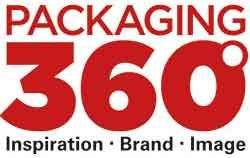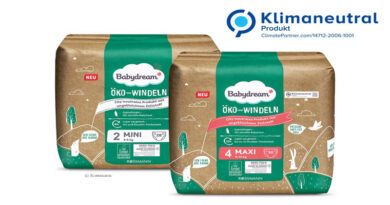It only works with print: the printing industry gives packaging, whether made of film or cardboard, that all-important look. Packaging printing remains the fastest growing area in the print media industry.
The appetite for frozen pizza has grown,: around one billion are sold in Germany every year. When packaged foods are in hot demand, this also pleases the manufacturers of printing presses. This is because the demand for boxes, for example, is rising in line with the pizza trend. Press manufacturer manroland Goss (formed in 2018 from by the merger of manroland web systems and Goss International) has now entered this growth market more forcefully, planning to build a fully automated packaging printing factory by the end of 2021 with a packaging company that has so far operated under the project name ROSA. At the heart of the new printing factory is the VARIOMAN c:line with web offset technology. The press prints more than 2,500 pizza boxes in one minute.
High demand for packaging
Other press manufacturers are also benefiting from the packaging boom, which was already omnipresent before the pandemic due to the high demand for consumer goods. On the one hand, since the start of the Corona crisis, there is once again more demand for large print runs -– for example, for hamster stockpiling supplies in the food sector -– and on the other hand, press manufacturers are picking up on the trends in packaging printing: eEver smaller batch sizes, more individual packaging variants and more sophisticated finishes using special colors or effects, for example. Packaging companies and brand manufacturers want to visually appeal to consumers at the point of sale in stationary retail, but also in online retail. This can only be achieved with the right printing. The consumers, and therefore the customer of the press manufacturers, also wants speed and sustainability at the same time: they do notn’t want to wait long for the product and want to act as ecologically as possible when purchasing it. In short, production speed alone is no longer the decisive factor for profitable production.
Complex requirements
The complexity of requirements has become an economic challenge for the packaging printing industry, particularly with the Corona pandemic, due – among other things – to the shortage of raw materials and cost increases in all areas. The associations do not yet dare to make a forecast for the current year. However, packaging printers are „resilient to the downturn in the economy,“ says Heidelberger Druckmaschinen AG, one of the world’s largest suppliers to packaging printers. The major player in the market is optimistic. Despite the pandemic, demand for printing systems, especially in Asian core markets, is roughly back at pre-crisis levels. The Heidelberg company generated half of its sales with sheetfed offset presses in the 2019/2020 fiscal year 2019/2020.
Printing pProcess
As different as the consumer goods and with it the packaging turn out to be, so different are the materials that packaging printing designs. It isPackaging printing printed prints on paper, cardboard, sheet metal or plastic and foil. The vVarious printing processes are used.
Flexographic printing, gravure printing and offset printing are the three major processes, which account for around 80 percent of the global market in terms of value. There are special machines for each process.
Offset printing dominates when printing fiber-based materials, folding cartons such as for cosmetics packaging, confectionery, frozen goods or medicines. There are two process variants: Sheetfed offset and web offset. According to the German Engineering Federation (VDMA), sheetfed offset is the most commonly used printing technology and prevails among 66 percent of all print service providers, a 2018 survey showed. The association expects offset printing to continue to dominate the market.
The flexographic printing process is often used when printing on film, for products such as pouches, food packaging, and lidding films. Packaging made of corrugated board or paper can be printed using offset or flexographic printing.
Rotogravure printing -– the oldest process -– has lost market share to flexo and offset printing in recent years. Rotogravure printing is the most complex process, but offers high quality with detailed printed images, as very fine printing screens are also possible at high speed. In particular, gGravure printing particularly makes sense for very long print runs in the food industry (branded goods), as any higher prepress costs are then offset.
Other printing processes are: Letterpress, indirect letterpress, screen printing and pad printing.
The newer processes include digital printing and 3D printing, where companies such as Landa from Israel are pioneers. (A separate article on digital printing can be found in this issue). Digital processes make enable customized
Among the newer processes are digital printing and 3D printing, where companies such as Landa from Israel are pioneers. (You will find a separate article on digital printing in this issue). Digital processes make customized contracts with printing, service, software, and logistics possible. Although these innovative technologies are in demand, the major packaging printers are sticking with traditional processes such as offset printing, which are more economical to cover and have a proven track record.
Automated workflow
A major advantage of conventional printing processes is the fully automated workflow. With the aid of digital data transfer, this makes it possible to handle large print jobs with little manpower and to meet the demand for individualization -– for example, in the case of special editions from by branded companies. The degree of automation is an important factor for press manufacturers and users. Fast changes of quantities on the press without loss of time due to downtimes and with, little manual operation can be mastered without any problems.
For folding carton printers, Heidelberg Druckmaschinen AG has developed an end-to-end workflow with the Speedmaster XL 106 press, including postpress at the die cutter and the folder gluer. The Speedmaster XL 106 relieves the operators of routine tasks, navigates him them through the various makeready processes, and thus boosts efficiency.
One example of its intelligent assistance system is the Wash Assistant. It selects the most suitable wash program. This not only saves on washing agents, but also increases the production capacity of the press by up to 125 hours a year. Transparency and quality assurance throughout production is are ensured by a new function that codes each sheet with a unique number.
The technically advanced manroland Goss press for the pizza boxes is expected to be ready for production at by the end of 2021, with an automatic unwinder with web accumulator and butt splicer, web cleaning, web edge control, special tension unit plus five offset printing units, a flexo printing unit, an electron beam hardener, and an inline rotary die cutter, among other features. It will also print cardboard in other thicknesses, such as for cups. The Varioman web offset solution is said to enable an overall production output that exceeds sheetfed offset printing by up to 100 percent.
Postpress
The printing and postpress equipment used in packaging printing differs from that used in conventional paper printing because the packaging material is generally thicker. In offset printing in particular, for example, it is of considerable importance whether a newspaper or folding box enters the press.
In postpress, i.e. the step after the actual printing, machines are used for further processing such as die cutting, varnishing or for embossing. New requirements are emerging here as a result of the trend towards more finishing. Longer and more complex press configurations are required, for example, when individual sequences of coating, printing and drying units are required to implement different applications.
Print finishing can take place either inline (in the press) or in a subsequent process (offline). There are machines that print, finish and die-cut in a single pass.
Gloss and metallic effects, haptic unpacking experiences through embossing, holograms or soft surfaces are also in demand and make the make-ready process more complex. But here, too, the solution is an automated workflow and digital data control. Automated logistics, for example with the help of robots or autonomous systems, can save even more resources when disposing of printing plates.
The process chain in finishing is becoming increasingly digital -– also driven by shorter runs, for example to design labels differently for different countries, explains Walter Kurz, Chairman of the Leonhard Kurz Foundation.
Finishing
Finishing is used not only for visual appeal at the point of sale, but also to protect goods and ensure product safety, for example through scratch-resistant coating or traceability. There are also different processes for finishing, depending on the requirements and material. Whether classic plastic injection molding, varnishing, hot foil stamping, foil laminating, flocking or laser die-cutting: tThe list of process technologies and innovations has grown longer.




